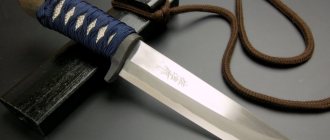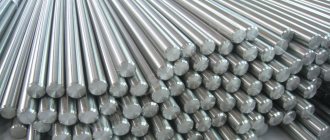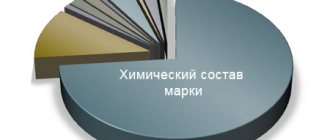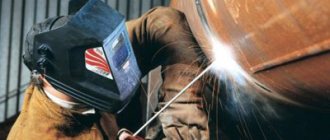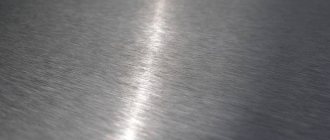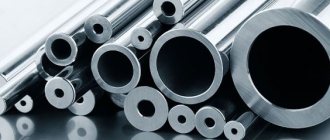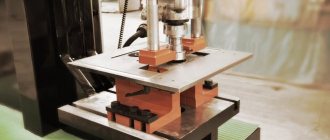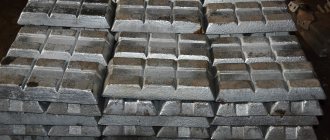Explanation of the name
The letter “X” in the abbreviation X50CrMoV15 indicates that the steel is alloyed and contains additional components. Which provide additional characteristics to the alloy. The number “50” indicates a carbon content of 0.5 percentage.
The following “Cr” indicates the presence of chromium in the alloy. Next, “Mo,” tells us about the presence of molybdenum in the steel. This makes the blade tougher and prevents the product from becoming brittle and brittle. The presence of vanadium is indicated by the letter “V”. And the final number “15” tells us about the total amount of carbon and alloying additives of 15%.
History of discovery
Molybdenum was discovered in 1778 by the Swedish chemist Carl Scheele - the oxide MoO3 was obtained. In 1782, P. Ghelm first obtained Mo in the metallic state, but contaminated with carbon and molybdenum carbide. Pure metal was obtained in 1817 by the Swedish chemist J. Berzelius.
The first attempts to use molybdenum in steel metallurgy date back to the end of the last century. Its industrial production began in 1909-1910, when the special properties of gun and armor steels alloyed with this metal were discovered, and a technology for producing compact refractory metals using powder metallurgy was developed.
Chemical composition of steel X50CrMoV15
The characteristics of steel are determined by its composition. You can see it in the table below:
| C,% | Cr,% | Mn,% | Mo,% | P,% | Si,% | S,% | V,% |
| 0,45-0,55 | 14-15 | 1 | 0,5-0,8 | 0,04 | 0,5-1 | 0,015 | 0,1-0,2 |
Table. Chemical elements and their significance in the composition of knife steel
| Chemical elements and their significance in the composition of knife steel: | |
| Carbon (C) | Without enough carbon it is very difficult to obtain a suitable hardness. This is the most important element in steel, it increases its strength. |
| Chromium (Cr) | gives the alloy increased anti-corrosion properties, chromium carbides increase wear resistance and hardenability. The high chromium content in the alloy affects its brittleness. |
| Manganese (Mn) | increases wear resistance and strength. Its content has a positive effect on the grain structure of the alloy and also contributes to excellent hardenability. |
| Molybdenum (Mo) | prevents steel from becoming brittle and allows it to maintain strength at high temperatures. Also increases corrosion resistance, strength, toughness. |
| Silicon (Si) | increases the strength and wear resistance of steel, like manganese, it makes steel more stable and reliable. |
| Vanadium (V) | forms the structure of carbides in such a way as to increase wear resistance, survivability and hardenability. |
| Nickel (Ni) | increases corrosion resistance and prevents steel from rotting. Increases the strength of steel. |
| Niobium (Nb) | the best carbide former, which provides corrosion resistance, ductility, and wear resistance. |
| Tungsten (W) | increases the wear resistance of steel, increases its stability during hardening and resistance to high temperatures. |
| Cobalt (Co) | enhances the effects of other individual elements in more complex alloys. Increases strength and hardness. |
| Sulfur (S) | is a harmful impurity, leading to the formation of cracks and tears. Typically, the sulfur content of high-quality steel is limited. The presence of sulfides is unacceptable for critical parts. |
| Phosphorus (P) | worsens the plastic properties of the alloy, causing the phenomenon of cold brittleness. In steels, phosphorus content is allowed in very small quantities. |
Application of molybdenum and its properties
Due to its properties, the use of molybdenum in industry is widespread in Russia and the world. Metallurgy, aviation industry, mechanical engineering, agriculture - this is not the whole list where this strategic metal is used. It is in such demand that the price of molybdenum is steadily increasing from year to year.
Material characteristics
Physical properties. Molybdenum is a gray rare earth metal that is similar in appearance to lead. Melting point 2619 ºС. It is distinguished by increased plasticity. Young's modulus is 336 GPa, which is 1.5 times more than steel. The density is 10.2 gcm3.
Tungsten is considered the most heat-resistant metal. But with regards to specific heat resistance at temperatures up to 1400 ºС, molybdenum has no competitors. Molybdenum has a low coefficient of linear expansion.
When the temperature changes by 1000 ºС, its size will increase by only 0.0049 mm.
Thermal conductivity is 300 Wm K. Electrical resistance is 5.6 μOhm cm. After preliminary mechanical and thermal treatments, the strength of the metal can be 20-23 kgmm2. Has paramagnetic properties.
Among the disadvantages, we note low plasticity at temperatures below -30 ºС.
Chemical properties. Molybdenum is completely resistant to environmental influences under normal atmospheric conditions. The oxidation process begins at 420 ºC, forming a low-hardness compound, molybdenum oxide.
Molybdenum is inert to hydrogen at temperatures up to 2620 ºС. Neutral to such elements as carbon, fluorine, silicon, nitrogen, sulfur. Molybdenum does not enter into chemical reactions with the main types of acids: hydrochloric, sulfuric, nitric, fluoric.
Technological properties. At room temperature, a molybdenum circle with a radius of 5 mm can be tied into a knot without the use of special equipment or rolled out to a thickness of 0.1 mm. This malleability of the metal contributes to the production of different types of rolled profiles.
Molybdenum can be easily processed by cutting, provided that a sulfur-based cutting fluid is used.
Molybdenum does not stand out for the quality of its welds. Belongs to group 3 weldability. The welding process is carried out using the arc method. To give welded joints greater ductility, the contact zone must be in a protective gas environment. Preference here is given to helium or argon.
Biological properties. Molybdenum is contained in the human body in the range of 8-10 mg. First of all, it affects the course of anabolic processes. Enhances the effects of vitamin C, thereby strengthening the immune system. Molybdenum is a copper regulator and prevents its accumulation in the blood.
Molybdenum alloys have a characteristic chemical composition - a low percentage of alloying elements. Only two-component solid solutions have a significant percentage of tungsten in their composition (up to 50%).
The main domestic brands of molybdenum alloy are:
- Molybdenum alloy TsM-2A. Alloying additives are titanium (0.07-03%) and zirconium (0.07-0.15%). In addition to these elements, it may include carbide phases (up to 0.004%). The tensile strength is 30 kgmm2. It drops significantly after passing the temperature threshold of 1200 C. The main advantages of the alloy are manufacturability and ductility, which make it possible to obtain industrial semi-finished products from it.
- Molybdenum alloy VM-1 does not differ significantly from the alloy described above. It has similar indicators of both chemical and mechanical properties.
- Molybdenum VM-2 contains a higher percentage of zirconium, making it more heat-resistant. This allows it to withstand ambient temperatures of 1300-1400 C. It has a tensile strength of 48 kgmm2, 1.6 times higher than that of TsM-2A.
- Additional alloying of the VM-3 molybdenum alloy with titanium (1.3%), zirconium (0.6%), and niobium (1.8%) leads to a further increase in heat resistance. Withstands loads up to 27 kgmm2 at temperatures up to 1360 C. However, VM-3 has a reduced level of ductility. This makes it less technologically advanced and limits its use in production.
Application options for molybdenum
As a heat- and corrosion-resistant material, it is used in the production of the most loaded parts of mechanisms and structures of various types of industry. Among its main purposes it should be noted:
- Application in the aviation industry in the manufacture of various components of turboprop jet engines: air intakes, turbine blades, etc.
- The rocket and space industry uses molybdenum in the production of individual parts of aircraft units: nose cones, heat reflectors, rudders, honeycomb panels, casing, etc. This happens due to the relationship between heat resistance and density. Although molybdenum is inferior in absolute heat resistance to tungsten, it is ahead of it in specific resistance. Therefore, at temperatures below 1350 it is more profitable to use molybdenum, because the weight of the structure is significantly reduced.
- Use in metallurgy as an alloying additive. Molybdenum refines the grain structure of steel, thereby strengthening it. In addition, there is an increase in corrosion resistance, hardenability and hardness. Adding 0.3% molybdenum to steel increases its strength by 3 times.
- In electrical engineering, it is used in the manufacture of tungsten filament holders in incandescent lamps. This use is associated with molybdenum’s properties of maintaining linear dimensions at elevated temperatures.
- In mechanical engineering, molybdenum is used as a material for sleeves of sliding bearings and balls of rolling bearings. Tips of cutting tools: countersinks, drills, turning tools, milling cutters.
- Molybdenum electrodes are used in electric furnaces to melt glass, due to the fact that the metal does not enter into chemical reactions with silicon oxide.
- Molybdenum sulfides serve as high-temperature lubricants in critical friction components.
- In heating engineering it is used as a material for heaters and thermal insulation of vacuum furnaces.
- In medicine, molybdenum is a raw material in the production of technetium, which serves as a means of diagnosing malignant tumors.
- In agriculture, molybdenum is added to fertilizers. Molybdenum has been proven to increase plant growth.
It is even added to engine oil due to its anti-corrosion properties. For example, it can be found in oil with a viscosity of 10W40.
Types of scrap
Molybdenum-containing waste is standardized by GOST 1639-93. According to it, molybdenum scrap is divided into:
- Pure molybdenum in the form of pieces of pipes, rods, rods, slabs, plates, etc. metal not lower than 99%. On the rare earth metals market in Moscow, this type of scrap is the most profitable in price.
- Lump waste with 2% contamination and weighing at least 20 g.
- Remains of electrodes, parts of electric vacuum furnaces, X-ray tubes, electric heater elements with a metal content of up to 95%.
- The name is similar to the previous paragraph, but the amount of molybdenum is 98%.
- Wire and shavings. Molybdenum 90%.
- Powdered molybdenum with a content of foreign impurities of no more than 5%.
- Pastes, seeds and other compounds based on molybdenum. Pure metal 75%.
This division is conditional. More detailed information can be obtained directly from scrap metal collection points in Moscow or another region of Russia.
Pros and cons of alloy 1.4116
Steel grade X50CrMoV15 is used in various fields of activity. It is used to make simple kitchen products and scalpels for medical purposes. High-carbon, stainless steel with the addition of molybdenum and vanadium has its advantages and disadvantages, consider them:
pros
- the level of hardness is sufficient for good knives at 54-56 HRC;
- the cutting edge and shine of the product remain sharp for a long time;
- good corrosion resistance;
- high wear resistance of products;
- no risk of mechanical damage;
- alloy knives are easy to sharpen, even in camping conditions;
- blades retain their shape when rubbed;
- a properly tempered item will not stain.
Minuses
- steel is prone to patina;
- may lose its original shine;
- Over time, the product becomes dull without use.
But the owner’s attitude towards the knife should be taken into account. All disadvantages appear in products that remain in a damp and dirty environment for a long time. Staying in this state for a long time leads to the appearance of the disadvantages described above.
Corrosion and its features
I noticed that while describing the qualities of stainless steels and noting their need and usefulness for industry, I have not yet focused on why they are so important. The main property of stainless steels is the ability to resist corrosion, so a few words about what it is.
Corrosion is the process of destruction of the surface of metals as a result of purely chemical or electrochemical action of the external environment, usually aggressive. In general, metal corrosion is accompanied by the formation of destruction products on the surface, such as rust, but there are also destructions without external manifestations. The intensity of corrosion depends on the properties of the metal and the degree of aggressiveness of the environment.
Corrosion is a fairly broad concept and is characterized by various manifestations:
- continuous (uniform) corrosion, when the entire surface of the metal is destroyed;
- point (local, crevice, pitting) corrosion, when individual areas of the metal surface are destroyed;
- intergranular corrosion, when corrosion spreads deep into the product along the grain boundaries;
- stress corrosion (corrosion cracking), when cracks develop on the metal surface due to the simultaneous influence of tensile stresses and an aggressive environment.
A separate type is electrochemical corrosion, when electrochemical processes at the interface are added to the purely chemical processes of interaction between the metal and the environment. This is the most destructive type of corrosion.
Application of X50CrMoV15 steel
X50CrMoV15 steel is used in industries with increased hygienic requirements. It is used for the manufacture of medical equipment and in the pharmaceutical industry. It is also used in the food and processing industries.
From all this it follows that the alloy is perfect for making knives. The optimal percentage of alloying substances provides the metal with high corrosion resistance. And also excellent mechanical strength and durability of the cutting edge.
Knives made from this steel have been shown in tests; in some areas, the parameters are better than those of their analogues. Alloy Products:
- holds an edge well;
- do not change their color;
- less susceptible to oxidation;
- ideal for intensive use;
- have a perfect appearance.
Molybdenum Products
The industry produces a wide variety of products. The most common are molybdenum wire, molybdenum rods, molybdenum powder, rod, sheet.
Molybdenum rods, as well as wire and tape, are used for the manufacture of heaters for high-temperature electric furnaces. In addition, rods are used for the manufacture of bushings for electric vacuum devices. The wire has found application in the production of high-temperature thermocouples, incandescent lamps, receiving-amplifier and generator lamps, and X-ray tubes. The sheets are used as a structural material for the production of products in the aviation and space industries. Molybdenum powder acts as an alloying additive to various steels and alloys. It is also the starting material for the production of compact molybdenum.
Care of steel knives
X50CrMoV15 steel plate.
Despite technological treatments and additional components in the 1.4116 alloy, the knife blade must be kept in a dry place or in a sheath. If the product has lost its shine, it can be restored with a non-abrasive car polish.
Large areas of patina or rust do not form on blades made of X50CrMoV15 steel. The blade will not require treatment with fine-grained sponges. They remove large pockets of corrosion. You can also use vegetable oils to prevent stains from appearing:
- clove;
- sunflower;
- from camellias.
It is best, after drying the blade, to rub it with a polishing agent containing wax. For long-term service of the product, it should be looked after. Without such an approach, no steel will maintain the quality given to it during production.
Durability: Chrome vs Stainless Steel
Is chrome more durable than stainless steel? With proper care, chrome steel can serve you for many years. It is durable when used correctly and in the right conditions.
The ideal environment for chrome steel is dry areas. This location should also be free of elements that can cause crevice and chemical corrosion.
Once chrome steel penetrates, there is a high chance that it will begin to rust. There are many things that can penetrate the surface of chrome steel. These include jigs, door frames, and metal tools.
Once the rust process has begun, it can quickly spread under the chrome layer.
Chrome steel is not completely reliable in terms of durability.
On the other hand, stainless steel has undoubtedly proven itself to be one of the strongest metals. I will serve you for many years without damage from corrosion or rust.
Stainless steel products tend to be expensive, and this is due to the strength of the metal. This feature also makes it ideal not only for a wide range of applications, but also for heavy duty and hazardous applications.
Knives made of steel X50CrMoV15
The increased carbon content gives strength to alloy products. Knives made from it hold an edge for a long time. Blades made of rolled steel are close in quality to forged products. Stamped products are lighter than their counterparts. Less weight will allow the hand to work with the knife for a long time. Let's look at several products made from X50CrMoV15 steel.
Knife - bumblebee
A small fixed knife that will become a universal assistant for a hunter, fisherman or a simple tourist. The knife is made in the best traditions of Russian knifemaking - the geometry of the blade follows the contours of Russian northern knives and is made of X50CrMoV15 steel. Blade characteristics:
- Knife length: 245 mm;
- Blade length: 130 mm;
- Handle length: 115 mm;
- Blade width: 32 mm;
- Butt thickness: 4 mm;
- Blade material: X50CrMoV15;
- Handle material: Walnut;
- Country of origin: Russia;
- Production: Sander A.;
- Weight: 133 grams.
A universal assistant for the hunter.
Knife – kitchen No. 20
The new kitchen knife from the workshop of Sander A. is a fairly powerful and large knife, with a blade made of X50CrMoV15 steel and a spine of 4 millimeters. The handle is made of polypropylene, ergonomic and unpretentious. This knife can be used to perform almost the entire range of kitchen work - from chopping greens to cutting massive pieces of meat. Knife characteristics:
- Knife length: 275 mm;
- Blade length: 150 mm;
- Handle length: 125 mm;
- Blade width: 33 mm;
- Butt thickness: 2.5 mm;
- Blade material: X50CrMoV15;
- Handle material: Polymer;
- Weight: 175 grams.
Handmade product from the workshop of Sander A.
Knife – Santoku Boker Core
Boker presented an amazing collection of Core kitchen knives. All models have excellent design and are made of high quality materials. Santoku Boker Core is a comfortable, lightweight knife that is a pleasure to work with. Characteristics of the Santoku knife:
- Knife length: 290 mm;
- Blade length: 163 mm;
- Handle length: 125;
- Butt thickness: 2.7 mm;
- Blade material: X50CrMoV15;
- Handle material: ABS plastic;
- Manufacturer: Boker, Germany;
- Weight: 152 grams.
Boker santoku knife from the Core collection.
General information about chromium-nickel stainless steels
The main alloying elements that give chromium-nickel steel corrosion resistance in oxidizing environments are Cr (chromium) and Ni (nickel). Chromium promotes the formation of a protective dense passive film of Cr2O3 oxide on the surface of stainless steel. The concentration of chromium in steels of this group required to impart corrosion resistance to stainless steel is 18%.
Nickel belongs to metals that are or easily pass into the so-called “passive” state. In a passive state, a metal or alloy has increased corrosion resistance in an aggressive environment. Although, of course, this ability of nickel is less than that of chromium or molybdenum.
Chromium and iron form a solid solution in the alloy, and nickel in an amount of 9-12%, in addition, contributes to the formation of an austenitic structure. Due to their austenitic structure, chromium-nickel stainless steels are distinguished by high processability during hot and cold deformation and resistance at low temperatures.
Chromium-nickel austenitic stainless steels are the most widespread group of corrosion-resistant steels. They are also known in world practice under the general name of steels of type 18-10.
In our country, the most common grades of chromium-nickel stainless steels are: 12Х18Н10Т, 08Х18Н10Т (EI914), 08Х18Н10, 12Х18Н9Т, 03Х18Н11, 12Х18Н12Т, 08Х18Н12Б (ЭИ402), 02Х18Н11, 03Х19AG 3H10.
These stainless steels exhibit corrosion resistance in many oxidizing environments at varying concentrations and over a wide range of temperatures. They also have heat resistance and heat resistance, but at moderate temperatures.
